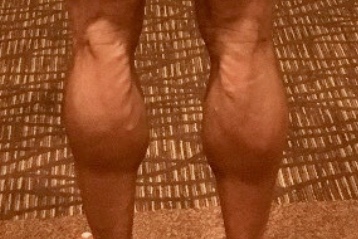
Let’s talk about calf training, let’s talk about you and me, let’s talk about all the good things and the bad things that can be, let’s talk about calves. I will tell you what I USED to think about calf training, that it was a waste of time. When I was a young girl, my calves were the same size as my thighs. This was NOT cool when baggy pants were in. Nothing was “baggy” on my calves. I hated them even. I never trained them. Not much anyway, till I began powerlifting. I didn’t want my calves to get “too big.” Yes, this is a confession. But! I have seen the light and I am proud to say I’m not only a calf training coach, but I am also a card-carrying, calf training member of the club. Sadly, it took a few injuries and an open mind to realize my erroneous ways but I’m here to tell you, ya gotta train those calves.
I was in my early 30’s when I began practicing yoga. It didn’t take long for me to realize my balance was significantly worse on my left side than it was my right side. I also realized I had to sit down to put shorts or pants on because my balance was so off. (The pain hadn’t kicked in yet). My yoga instructor told me to “pick up your arches.” I didn’t even know they were on the floor! If you are flat footed and have never tried to do this, I challenge you to. If you aren’t able to pick up your arch, or not without pain, good chance you need to train and stretch your calves too. If you're young and you've had some nice gains and now you've got some extra poundage on you, just wait and you'll see what I mean.
Here is a list of benefits calf training can do for you:
- Improve ankle strength, stability, and mobility
- Health and injury prevention of feet, ankles, Achille’s tendons, and calves
- Improves athletic performance; increases depth on squat
- Aids with balance
- Alleviates aches and pain in low back, hips, knees, and feet
- Heals (no pun) plantar fasciitis
- Overall increased range of motion
- Prevention in calf sprains
- Prevention in irregular blood flow in the lower extremities. The calf muscle has a very important function which is to return the blood from leg and foot to the heart.
- You could be sexier if your calf muscles were bigger. We all could be. It’s our obligation to society.
What is the calf? Other than a baby cow? It’s made up of two muscles: the soleus (the shorter/outer muscle) and the gastrocnemius (the longer/inner muscle). To target the soleus, perform calf exercises where the knee remains bent and the movement is done by moving up, onto the ball of the foot. This technique is very good for strengthening the foot and ankle, improving stability.
The gastrocnemius will be targeted by performing standing exercises, where the knee is locked out (or softly straight). This muscle is attached to the Achilles (the soleus is too, but not nearly as much).
It would serve you well to concentrate on both the soleus, the gastrocnemius and let’s not forget the front of the calf, the tibialis. What the what? Did she just say to “train your tibialis muscles?” Sure did. The tibialis anterior muscle lies within the front of your lower leg, attaching to the outside of your knee and the upper portion of the tibia bone on one end, and near the base of your big toe on the other. The muscle facilitates ankle flexion, also called dorsiflexion, and inversion, which occurs when you move your foot inward. Perform stretching and strengthening exercises that target the tibialis anterior to increase your range of motion, help the muscle function effectively and potentially prevent certain lower-leg injuries. I’ve posted the funny kettlebell pic of my husband and me before. I’ll post it here again so you can see:
Calves and tibialis muscles need love too! Please don't forget to do some good static stretching after training your calves and your tibialis. Stretch your toes, feet, ankles, and calves. Sit with your toes and knees on the floor, heels in the air, butt towards your heels for as long as you can. Then, flatten the tops of your feet on the floor and sit on your heels again (use a bolster or block to support your seat if you can't reach all the way to the floor). This stretch won't kill you and the more you do it, the less painful it will be.








